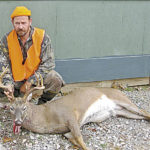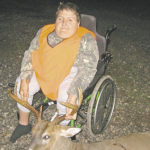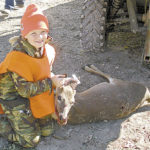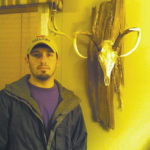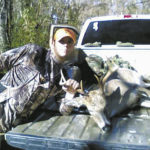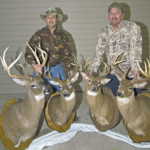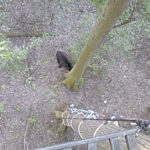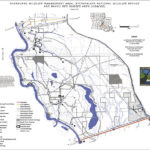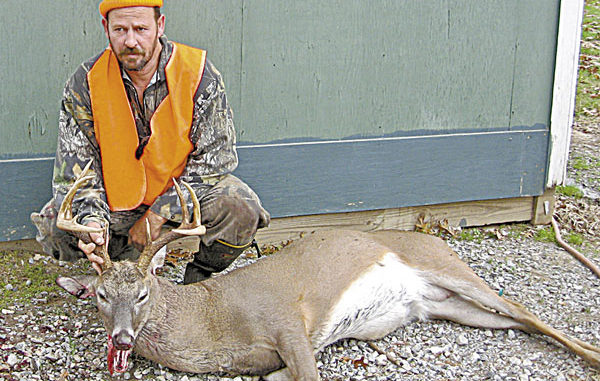
Put in your time, and you’ll likely be dragging a nice Sherburne buck back to your truck this month.
Alvin Fairchild was sitting in a climber, freezing to death. He had earned that right, walking far into Sherburne Wildlife Management Area to hunt an area in which he and life-long friend Floyd Coye had scored time and time again.
The problem wasn’t all that it was really, really cold. The real problem was that getting to this secluded backwoods wasn’t a stroll in the park — or even a walk through thick woods.
“We went by boat about ¾ of a mile, and then we walked another mile,” the St. Gabriel hunter said. “We broke ice getting back there.”
And much of that walk was through water. Sure, he was wearing chest waders, but that didn’t make any difference.
In fact, Fairchild had decided not to go all the way back to the most-productive part of the area because he just couldn’t bear the thought of risking the water lapping over his waders in the deepest sloughs he faced.
The huge number of trees downed when Hurricane Gustav blasted right over the area didn’t help the outlook.
“I refused to walk that far back that day,” Fairchild chuckled.
So Fairchild grabbed a tree while Baton Rouge’s Coye, son Matthew Coye and buddy Mark Yeager continued the long hike.
Now, sunlight was beginning to pierce the forest, and Fairchild knew he had set up facing the wrong direction.
“I was facing north, and right when you could just see, a rabbit runs by my stand going from south to north,” he said. “I knew I needed to turn around, but I’m old now and didn’t want to risk it.”
His hunch was confirmed minutes later when a doe walked by following the path of the rabbit.
Fairchild squeezed off his first-ever shot with a crossbow — and missed clean.
“If you’ve ever tried to reload a crossbow in a stand, I’ll tell you it’s not easy,” he said.
He struggled not only with preparing for another shot, but also with his decision to remain facing north — which made a shot in the direction of where the doe and rabbit appeared difficult.
“I told myself, ‘You need to turn around and face south,’” Fairchild said. “But I stayed where I was.”
He eased his phone out and texted Floyd Coye that he had just missed a doe.
“He texted back, ‘Did you hit it?’ and I texted, ‘No,’” Fairchild said.
As he hit the “send” button, a noise caught his attention.
“I hear the ice crunch, and I look to my right,” he said. “As I turn to the right, all I can see is horns.”
A huge buck was right there, just begging to get shot.
Of course, shooting to that side was difficult, so Fairchild began to ease to a standing position so he’d be able to lean out and get a shot.
What he didn’t know was that there were other eyes nearby.
“A doe had snuck up on me, and she blew,” Fairchild said.
That was all the buck needed — it and the doe bounded away out of range.
“They ran about 75 yards, and turned and looked at me,” Fairchild said. “They were right there, and I could only think, ‘If I had my rifle, he would be dead.’”
And then salt was jammed into his wound.
“While I was sitting there looking at them, I got a text (from Coye) that said, ‘I stuck a big one,’” Fairchild said. “I texted back, ‘What?’”
Coye had pushed on to a favorite area, dropping off his son Matthew and Yeager before climbing into a tree in which he had missed a big buck the previous week.
“For a week I prayed I missed, that it wasn’t back there dying,” Coye said.
A few minutes after 7 a.m., about the time Fairchild was spooking a deer of his own, Coye saw a buck — the very same one he had missed the week before — slipping through the knee-deep water.
“I had some scent bombs out, and he walked in, and at 40 yards he stopped,” Coye said. “He was quartering hard to me, and I was just saying, ‘Come on, keep coming.’ He was looking at me.”
The deer stopped, and then continued to draw closer to the hunter. It finally stopped, and looked right up at Coye. But it was too late.
Coye shot, and this time he didn’t miss.
“It was the most awesome thing to see it take off,” he said. “I could see the blood pumping out of him.”
The buck fell within site of Coye and son Matthew, who had watched the kill unfold. After the elder Coye texted Fairchild, both Coyes climbed down and hurried to the deer.
“Half his horns were in the water,” Floyd Coye said. “We hugged some, kissed and hugged some more. We high-fived I don’t know how many times.
“It was just so unreal to share (the hunt) with my son.”
When they finally got around to pulling the deer’s head out of the water, they were stunned to find a massive 11-point rack crowning the buck.
“There was no ground shrinkage,” Coye said. “It was only growth.”
Six-inch brow tines and G2s that measured 13 and 15 inches were enhanced by 9-inch G3s. It was just a massive animal.
It later scored 160 inches Pope & Young.
And right across the back of the deer was a cut.
“I had creased him the week before,” Coye said. “The cut was even in the kill zone. He just ducked my arrow.”
Coye and Fairchild have killed many deer on Sherburne in the more than 20 years they been hunting it.
There’s no doubt that the pair of hunters have invested a lot of work into their hunts. Sherburne is nothing more than a swamp, crisscrossed with sloughs and meandering bayous that guarantee a wet day in the woods.
But that hasn’t been a deterrent, even though the hunters are now in their mid 50s.
“We see so many deer,” Fairchild said.
Things have changed, however.
Some of those changes have to do with their attitudes on hunting.
“We went from shooting spikes to shooting little baskets to shooting bigger bucks,” Fairchild said. “The last five years, we’ve killed more quality deer.”
And the destructive force of Hurricane Gustav in 2008 only added to the rise in quality, mainly because the downed trees have made it much more difficult to get long shots.
“When we first started hunting Sherburne, the woods were beautiful,” Coye said. “You could see for a long way.
“Now it’s so thick. Your furthest shot is probably going to be 60 to 70 yards.”
However, the property has held quality deer for its entire history as a WMA. Take Fairchild’s very first hunt on the property back in 1986.
The two buddies were slipping through the woods when Coye saw a group of deer in front of them. He quickly stopped, and signaled for Fairchild to do the same. Fairchild slipped up and knelt next to Coye.
“I’m trying to get a bead on this little basket-rack (buck), and I hear ‘click,’” Coye said.
He glanced down at Fairchild, who was pointing his rifle the other way. Coye looked back, and couldn’t believe his eyes.
“I see this deer going through the woods like a horse,” Coye said.
Fairchild popped a shot, but the buck never let up.
“I asked if he hit it, and he says, ‘I think I just made it run faster,’” Coye laughed.
A second shot missed as well.
That hooked Fairchild, and confirmed what Coye had come to know about the property. In the succeeding years, the hunters have put numerous bucks on the ground — and each scored two really nice deer that now adorn their walls.
And that has kept them coming back year after year after year.
“It’s the success we have,” Coye said. “Six of us hunted last year, and we killed 20 deer and seven hogs.
“I mean, what can we do?”
